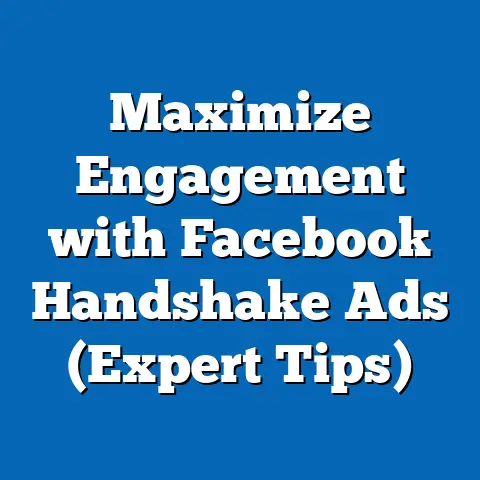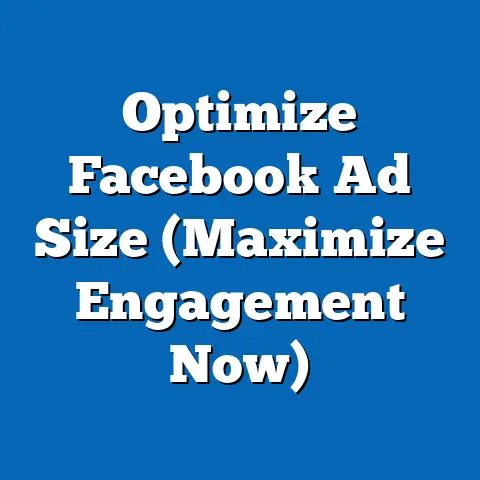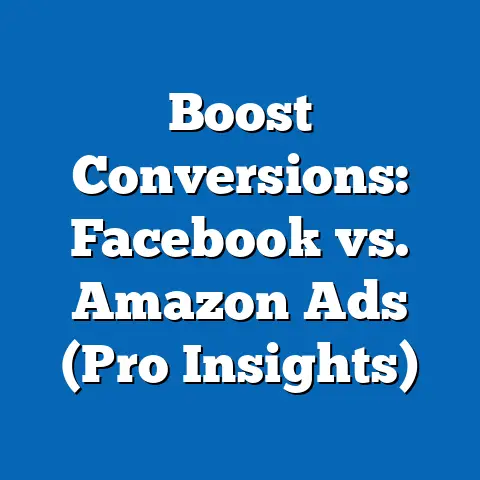Boost Facebook Lead Gen with CRM Tactics (Pro Guide)
Facebook has become an undeniable force in the advertising world, and for good reason. It offers unparalleled reach and sophisticated targeting capabilities, making it a prime platform for generating leads. I remember when I first started experimenting with Facebook Ads, I was blown away by how precisely I could target my ideal customer. However, simply running ads isn’t enough. To truly maximize your lead generation potential, you need a smart strategy that integrates your Facebook efforts with a robust CRM (Customer Relationship Management) system.
Think of your Facebook Ads as the fishing net, casting out to capture potential customers. Your CRM, then, is the processing plant where you sort, nurture, and convert those leads into loyal clients. In today’s fiercely competitive digital landscape, this integration is no longer optional; it’s essential. Without it, you’re essentially throwing away valuable leads and wasting your advertising budget.
According to recent studies, companies that effectively integrate their CRM with their marketing efforts see a significant increase in lead conversion rates. We’re talking about a potential boost of 25-30% – numbers that can dramatically impact your bottom line. But the integration goes beyond just capturing leads; it’s about understanding their behavior, personalizing their experience, and nurturing them through the sales funnel.
The thesis of this guide is simple: Leveraging CRM tactics can significantly enhance Facebook lead generation. We’ll explore how seasonal trends can be strategically used to maximize lead capture, and how the integration of CRM systems is essential for sustained business growth. So, let’s dive in and unlock the potential of Facebook lead generation with the power of CRM!
Tapping into Seasonal Trends
One of the most effective ways to boost your Facebook lead generation is by leveraging seasonal trends. It’s a strategy that I’ve personally found incredibly rewarding, allowing me to capitalize on increased consumer interest and tailor my messaging for maximum impact.
Understanding Seasonal Trends
Seasonal trends are predictable patterns in consumer behavior that occur around specific times of the year. These trends can be driven by holidays (like Christmas or Thanksgiving), seasonal events (like summer vacations or back-to-school shopping), or even specific times of the year (like tax season or the start of a new sports season). Recognizing and understanding these trends is crucial for any business looking to optimize its lead generation efforts.
Think about it: during the holiday season, people are actively searching for gifts, decorations, and festive experiences. Summer brings a surge in travel-related searches, outdoor gear purchases, and home improvement projects. Back-to-school season sees parents scrambling for school supplies, new clothes, and educational resources.
By understanding these patterns, you can anticipate increased demand and tailor your Facebook ads to meet the specific needs and interests of your target audience during these peak periods. This means crafting compelling ad copy, using relevant visuals, and offering promotions that resonate with the seasonal theme.
For example, a clothing retailer might promote winter coats and accessories during the holiday season, while a travel agency might focus on summer vacation packages in the spring. A software company could offer special discounts for students and teachers during the back-to-school season.
Aligning Facebook Ads with Seasonal Trends
Once you’ve identified the relevant seasonal trends for your business, the next step is to align your Facebook ads accordingly. This involves several key steps:
- Timing is everything: Launch your campaigns well in advance of the seasonal event to build awareness and capture early interest. Don’t wait until the last minute to start advertising; by then, your competitors will already be ahead of the game. I’ve found that starting a month or two before the peak season allows me to build momentum and maximize my reach.
- Craft compelling ad copy: Use language that resonates with the seasonal theme. Highlight the benefits of your products or services in the context of the event. For example, instead of simply saying “Our software helps you manage your business,” you might say “Simplify your holiday season with our powerful business management software.”
- Use relevant visuals: Incorporate images and videos that capture the spirit of the season. Use festive colors, holiday decorations, or imagery that evokes the feeling of summer vacation. Visuals are incredibly powerful in capturing attention and conveying your message quickly.
- Offer seasonal promotions: Provide discounts, special offers, or bundled packages that are relevant to the seasonal event. A limited-time promotion can create a sense of urgency and encourage potential leads to take action.
For example, I once ran a campaign for a local bakery during the Thanksgiving season. We created ads featuring mouthwatering images of pumpkin pies, cranberry scones, and other holiday treats. The ad copy highlighted the convenience of ordering ahead and offered a discount for early bird orders. The results were phenomenal; we saw a significant increase in online orders and foot traffic to the bakery.
Case Studies
To illustrate the power of leveraging seasonal trends in Facebook lead generation, let’s look at a few real-world examples:
- Example 1: E-commerce during Black Friday/Cyber Monday: Many e-commerce businesses see a huge spike in sales during the Black Friday/Cyber Monday weekend. To capitalize on this trend, they create targeted Facebook ads featuring their best deals and promotions. They often use countdown timers in their ads to create a sense of urgency and encourage immediate purchases.
- Example 2: Travel industry during summer: Travel agencies and hotels often run Facebook ads promoting summer vacation packages and special deals. They use stunning images of beaches, mountains, and other vacation destinations to entice potential travelers. They also target specific demographics based on their travel preferences and budget.
- Example 3: Education sector during back-to-school: Schools, universities, and online learning platforms often run Facebook ads promoting their programs and courses during the back-to-school season. They target parents and students with ads that highlight the benefits of their educational offerings and offer special discounts for new enrollments.
Key Takeaway: Aligning your Facebook ads with seasonal trends is a powerful way to boost your lead generation efforts. By understanding consumer behavior and tailoring your messaging accordingly, you can capture increased interest and drive more leads to your business. The next step is to integrate these leads into a CRM system for effective management and nurturing.
Integrating CRM with Facebook Lead Gen
While capturing leads through Facebook is a crucial first step, it’s only half the battle. To truly maximize the value of those leads, you need to integrate them seamlessly into your CRM system. This integration allows you to manage, nurture, and convert those leads into paying customers more effectively.
Overview of CRM Systems
A CRM system is a software solution that helps businesses manage their interactions with current and potential customers. It’s a centralized hub for all customer-related data, including contact information, communication history, purchase records, and more.
Think of your CRM as your company’s memory. It remembers every interaction you’ve had with a customer, allowing you to provide personalized service and build stronger relationships.
There are many different CRM options available in the market, each with its own strengths and weaknesses. Some of the most popular CRM systems include:
- Salesforce: A leading CRM platform known for its robust features and customization options. It’s a great choice for large enterprises with complex sales processes.
- HubSpot: A popular CRM for small and medium-sized businesses, known for its user-friendly interface and marketing automation capabilities.
- Zoho CRM: A cost-effective CRM option that offers a wide range of features and integrations. It’s a good choice for businesses on a tight budget.
- Microsoft Dynamics 365: A comprehensive CRM platform that integrates seamlessly with other Microsoft products. It’s a good choice for businesses that already use Microsoft Office and other Microsoft tools.
The best CRM for your business will depend on your specific needs and budget. Consider factors such as the size of your business, the complexity of your sales process, and the features you need.
Benefits of CRM Integration
Integrating your CRM with Facebook Lead Ads offers a multitude of benefits:
- Streamlined lead management: Automatically transfer leads from Facebook to your CRM, eliminating the need for manual data entry and saving you valuable time. This ensures that no lead falls through the cracks and that all leads are properly tracked and managed.
- Improved lead quality: Capture more accurate and complete lead information through Facebook Lead Ads, and automatically enrich that data with additional information from your CRM. This gives you a more complete picture of each lead and allows you to better qualify them.
- Enhanced lead nurturing: Use your CRM to segment leads based on their interests, demographics, and behavior, and then tailor your messaging and offers accordingly. This allows you to provide personalized experiences that resonate with each lead and increase their likelihood of conversion.
- Increased sales productivity: Equip your sales team with the information they need to close more deals, including lead contact information, communication history, and lead scoring data. This allows them to focus on the most promising leads and close deals faster.
- Better ROI on Facebook Ads: By tracking the performance of your Facebook ads in conjunction with your CRM data, you can identify which ads are generating the most qualified leads and optimize your campaigns for maximum ROI.
I’ve personally seen a dramatic improvement in my lead conversion rates after integrating my CRM with Facebook Lead Ads. The ability to automatically capture and manage leads, combined with the power of personalized lead nurturing, has been a game-changer for my business.
Step-by-Step Integration Process
The process of integrating Facebook Lead Ads with your CRM will vary depending on the specific CRM system you use. However, the general steps are as follows:
- Connect your Facebook account to your CRM: Most CRM systems offer a direct integration with Facebook Lead Ads. You’ll need to authorize your CRM to access your Facebook account.
- Map your Facebook Lead Ads fields to your CRM fields: This ensures that the data captured in your Facebook Lead Ads is properly transferred to the corresponding fields in your CRM.
- Set up automation rules: Configure your CRM to automatically trigger certain actions when a new lead is captured from Facebook. This could include sending a welcome email, assigning the lead to a sales representative, or adding the lead to a specific marketing list.
- Test the integration: Submit a test lead through your Facebook Lead Ad to ensure that the data is being transferred correctly to your CRM.
Many CRM systems also offer pre-built integrations with Zapier, a popular automation platform. This allows you to connect Facebook Lead Ads with thousands of other apps and services, even if your CRM doesn’t have a direct integration.
Key Takeaway: Integrating your CRM with Facebook Lead Ads is a crucial step in maximizing the value of your leads. By automating the lead capture process, improving lead quality, and enhancing lead nurturing, you can significantly increase your lead conversion rates and drive more sales for your business.
Effective CRM Tactics for Lead Generation
Once you’ve integrated your CRM with Facebook Lead Ads, the real work begins. Now it’s time to implement effective CRM tactics to nurture those leads and convert them into paying customers.
Lead Scoring
Lead scoring is the process of assigning a numerical value to each lead based on their characteristics and behavior. This allows you to prioritize your leads and focus on the ones that are most likely to convert.
For example, a lead who has filled out a form on your website, downloaded a white paper, and visited your pricing page would likely receive a higher score than a lead who has simply liked your Facebook page.
Your CRM system can automatically calculate lead scores based on pre-defined criteria. You can customize these criteria to reflect your specific business goals and target audience.
Here are some common factors to consider when creating a lead scoring model:
- Demographic information: Job title, company size, industry, location.
- Engagement metrics: Website visits, email opens, form submissions, social media interactions.
- Lead source: Facebook Lead Ad, website contact form, trade show.
By assigning different weights to each of these factors, you can create a lead scoring model that accurately reflects the likelihood of a lead converting into a customer.
Segmentation and Targeting
Audience segmentation is the process of dividing your leads into smaller groups based on shared characteristics. This allows you to tailor your messaging and offers to each segment, increasing the relevance and effectiveness of your marketing efforts.
For example, you might segment your leads based on their industry, job title, or product interest. You can then create targeted Facebook ads that speak directly to the needs and interests of each segment.
CRM data can significantly enhance your targeting in Facebook ads. By uploading your CRM data to Facebook, you can create custom audiences that match your existing customer base. You can then use these custom audiences to target similar people on Facebook who are likely to be interested in your products or services.
I’ve seen firsthand how effective this strategy can be. By creating custom audiences based on my CRM data, I was able to significantly improve the relevance of my Facebook ads and increase my conversion rates.
Follow-Up Strategies
Effective follow-up is crucial for nurturing leads and converting them into paying customers. Your CRM system can help you automate your follow-up efforts and ensure that no lead is left behind.
Here are some effective follow-up strategies to consider:
- Welcome email: Send a welcome email to new leads immediately after they submit a Facebook Lead Ad. Thank them for their interest and provide them with valuable information about your products or services.
- Personalized follow-up emails: Send personalized follow-up emails based on the lead’s interests and behavior. Use the information you’ve gathered in your CRM to tailor your messaging and offers.
- Automated email sequences: Create automated email sequences that nurture leads over time. These sequences can be triggered by specific actions, such as downloading a white paper or visiting your pricing page.
- Sales calls: For high-scoring leads, consider scheduling a sales call to discuss their needs and offer a personalized solution.
Automation features within CRMs can help you send timely follow-up emails or messages without requiring manual effort. This ensures that you’re staying top-of-mind with your leads and nurturing them through the sales funnel.
Key Takeaway: Implementing effective CRM tactics is essential for converting Facebook leads into paying customers. By using lead scoring, segmentation, and targeted follow-up strategies, you can increase the relevance of your marketing efforts and drive more sales for your business.
Measuring Success and Adjusting Tactics
The final, and arguably most important, step in optimizing your Facebook lead generation with CRM is to measure your success and adjust your tactics accordingly. Data is your best friend in this process.
KPIs for Measuring Lead Gen Success
Key Performance Indicators (KPIs) are measurable values that demonstrate how effectively you are achieving your business objectives. When it comes to Facebook lead generation, there are several KPIs you should be tracking:
- Cost per lead (CPL): The amount of money you spend to acquire each lead. This is a crucial metric for determining the ROI of your Facebook ads.
- Lead conversion rate: The percentage of leads who convert into paying customers. This metric measures the effectiveness of your lead nurturing efforts.
- Customer lifetime value (CLTV): The total revenue you expect to generate from each customer over the course of their relationship with your business. This metric helps you determine the long-term value of your leads.
- Return on ad spend (ROAS): The amount of revenue you generate for every dollar you spend on Facebook ads. This metric provides a comprehensive view of the profitability of your campaigns.
Your CRM system can provide valuable data for tracking these KPIs. By integrating your CRM with Facebook, you can automatically track the cost per lead, lead conversion rate, and customer lifetime value for each of your campaigns.
Analyzing and Adjusting Campaigns
Analyzing the performance of your Facebook ads in conjunction with your CRM data is crucial for identifying areas for improvement. Look for patterns and trends in your data to understand what’s working and what’s not.
For example, you might find that certain Facebook ads are generating a high volume of leads, but those leads are not converting into customers. This could indicate that the ads are attracting the wrong type of leads or that your lead nurturing process needs improvement.
Based on your analysis, you can adjust your campaigns to improve their performance. This could involve:
- Refining your targeting: Adjust your audience targeting to reach a more qualified group of leads.
- Optimizing your ad copy and visuals: Experiment with different ad copy and visuals to see what resonates best with your target audience.
- Improving your lead nurturing process: Implement more effective lead scoring, segmentation, and follow-up strategies.
- Adjusting your budget: Reallocate your budget to the campaigns that are generating the best ROI.
Continuous testing and optimization are essential for maximizing the performance of your Facebook lead generation campaigns. Don’t be afraid to experiment with new tactics and strategies, and always track your results to see what works best for your business.
Real-World Examples
I’ve seen numerous companies successfully adapt their CRM tactics based on performance analysis, leading to improved lead generation.
For example, one of my clients, a SaaS company, was struggling to convert Facebook leads into paying customers. After analyzing their data, we discovered that their lead nurturing process was not personalized enough. We implemented a more targeted email sequence based on the lead’s industry and product interest. As a result, their lead conversion rate increased by 20%.
Another client, an e-commerce business, found that their Facebook ads were generating a high volume of leads, but the cost per lead was too high. We refined their targeting to focus on a more specific audience and optimized their ad copy and visuals. As a result, their cost per lead decreased by 30%.
Key Takeaway: Measuring your success and adjusting your tactics is crucial for maximizing the ROI of your Facebook lead generation campaigns. By tracking the right KPIs, analyzing your data, and continuously testing and optimizing your campaigns, you can drive more leads and generate more revenue for your business.
Conclusion
In today’s digital landscape, Facebook remains a powerful platform for generating leads. However, to truly unlock its potential, you need a smart strategy that integrates your Facebook efforts with a robust CRM system.
Throughout this guide, we’ve explored the key steps involved in boosting your Facebook lead generation with CRM tactics:
- Tapping into seasonal trends to capture increased interest and tailor your messaging.
- Integrating your CRM with Facebook Lead Ads to automate the lead capture process and improve lead quality.
- Implementing effective CRM tactics, such as lead scoring, segmentation, and targeted follow-up strategies.
- Measuring your success and adjusting your tactics based on data-driven insights.
By implementing these strategies, you can significantly increase your lead conversion rates and drive more sales for your business.
I encourage you to start implementing these tactics today and to keep an eye on seasonal trends as you plan your next Facebook ad campaigns. Remember, the integration of CRM with effective lead generation strategies is essential for sustained business growth.
Don’t be afraid to experiment, test new approaches, and continuously optimize your campaigns based on data. With a little effort and dedication, you can transform your Facebook lead generation efforts and achieve remarkable results. The power to transform your business is at your fingertips. Embrace the data, leverage the tools, and watch your leads – and your revenue – soar!






